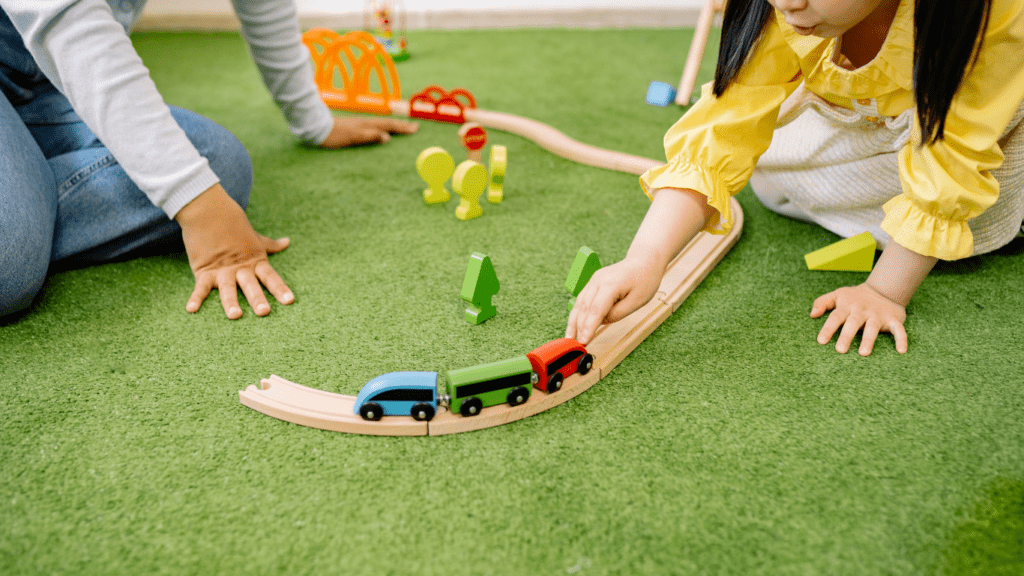Understanding the Impact of Lego Games
Lego games shape children’s development beyond entertainment. They offer structured, constructive experiences crucial for skill-building.
What Are Lego Games?
Lego games involve constructing models using interlocking bricks. Sets feature themes like :
- cities
- space
- popular movies that captivate young minds
These games blend creativity with problem-solving, requiring precise hand-eye coordination.
Overview of Child Development Stages
Children progress through distinct developmental stages. From ages 2-7, they develop fine motor skills, vocabulary, and basic problem-solving abilities.
Between 7-11 years, they enhance logical thinking and start understanding complex instructions. By adolescence, abstract thinking and advanced problem-solving become prominent.
Playing with Legos supports these stages, offering age-appropriate challenges that promote continuous cognitive and motor development.
Cognitive Benefits
Lego games provide significant cognitive benefits for children. These benefits extend beyond simple play, contributing to vital aspects of mental development.
Enhancing Problem-Solving Skills
Children face various challenges in Lego games. They identify problems, brainstorm solutions, and test their ideas. This iterative process enhances their problem-solving skills.
For example, constructing a Lego bridge forces kids to figure out load distribution and stability. As they navigate these challenges, they learn to approach problems methodically and develop critical thinking abilities.
Boosting Spatial Awareness
Lego games also boost spatial awareness. By manipulating bricks, children understand spatial relationships and dimensions. They visualize structures before building them, enhancing their mental rotation skills.
For instance, creating a 3D model from a 2D instruction manual requires translating two-dimensional images into three-dimensional constructs. This skill is crucial for subjects like math and engineering, where spatial reasoning is often vital.
Social and Emotional Growth

Lego games significantly contribute to social and emotional growth in children. By engaging in interactive play, children develop essential social skills and emotional resilience.
Fostering Teamwork and Collaboration
Playing with Lego sets encourages teamwork and collaboration. When children work together on a Lego project, they share ideas, delegate tasks, and solve problems collectively.
This cooperative play reinforces the importance of working as a team to achieve a common goal.
For example, while building a complex structure, one child might focus on designing the base while another constructs intricate details, teaching them to value each other’s contributions and coordinate seamlessly.
Encouraging Expression and Communication
- Lego games also enhance children’s ability to express themselves and communicate effectively.
- Children often narrate stories or explain their creations during play, improving their verbal communication skills.
- As they articulate their thoughts, they learn to describe concepts clearly and understand the perspectives of their peers.
For instance, a child explaining the functionality of a Lego spaceship to a friend sharpens their descriptive abilities and fosters open dialogue.
Creativity and Innovation
Lego games play a vital role in nurturing children’s creativity. They offer limitless possibilities, helping young minds think outside the box.
Building Creative Thinking
Lego games challenge children to create diverse structures and scenarios. By using different bricks and elements, they form complex designs, which enhances creative thinking.
For example, children might build castles, spaceships, or entire cities, each requiring unique problem-solving strategies. This constant exercise of coming up with new ideas and ways to implement them keeps their creative thinking sharp and dynamic.
The Role of Imagination in Growth
Imagination flourishes when children play with Lego. They dream up entire worlds populated with characters and stories. This imaginative play not only entertains but also contributes significantly to cognitive and emotional growth.
Creating narratives for their builds helps children understand storytelling elements, develop empathy, and explore emotional situations in a safe environment.
For instance, a child might construct a rescue mission scenario, which involves planning and emotional engagement, thus promoting holistic growth.
Physical Development Through Play
Playing with Lego games significantly contributes to a child’s physical development. While engaging in these activities, children enhance essential skills crucial for their growth.
Fine Motor Skill Enhancement
Lego games offer an effective way for children to improve fine motor skills. Manipulating small bricks and connecting pieces require precision and control, which strengthen hand muscles.
These activities help children develop dexterity and coordination, preparing them for tasks like writing or buttoning clothes. For example, building a castle involves carefully aligning and stacking bricks, enhancing finger strength and control.
Hand-Eye Coordination
Hand-eye coordination improves significantly through Lego play. Aligning bricks with connectors requires children to focus visually and coordinate hand movements.
This intricate task helps children synchronize their visual input with motor actions, promoting better manual precision.
For instance, when constructing a spaceship, children must accurately place each piece, improving their spatial awareness and hand-eye coordination skills.


